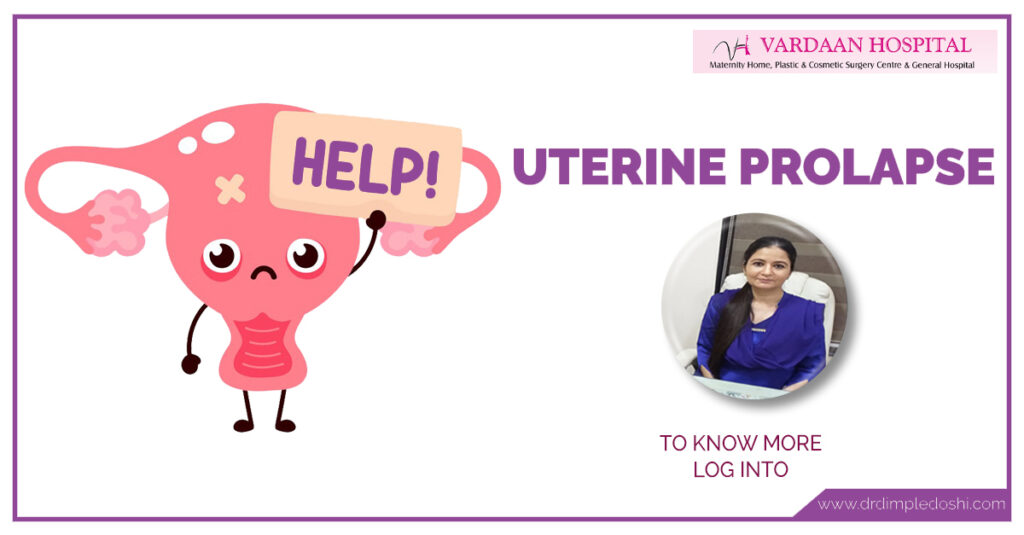Expert Uterine Prolapse Solutions in Goregaon West, Mumbai
Uterine prolapse
Overview
Uterine prolapse is often reported as “ something coming out through the vagina “. Prolapse occurs when the pelvic muscles of a woman weaken and are no longer having the strength to support the uterus; bladder or rectum. As a result, these structures can slip down and protrude out of the vagina, and this is PROLAPSE.
Uterine prolapse can occur in women of any age. But most commonly it affects postmenopausal women who have had vaginal deliveries.
ICD-10 Codes for Uterine Prolapse:
- N81.0: Prolapse of uterus, vaginal wall
- N81.1: Prolapse of uterus, cervix
- N81.2: Prolapse of uterus, complete
- N81.3: Prolapse of uterus with vaginal wall (anterior or posterior)
- N81.4: Prolapse of uterus with perineal body defects
CPT Codes for Treatment of Uterine Prolapse:
- 57240: Colporrhaphy, anterior or posterior, with or without repair of perineal body (used for anterior or posterior vaginal wall prolapse repair)
- 57250: Colporrhaphy, anterior or posterior, with repair of perineal body, with or without vaginal hysterectomy
- 58260: Vaginal hysterectomy, for prolapse repair (may include additional repairs such as colporrhaphy)
- 58150: Total abdominal hysterectomy (corpus and cervix), with or without removal of tube(s) and/or ovary(s) (when performing abdominal hysterectomy for prolapse)
- 57400: Colposcopy of cervix and vagina, with or without biopsy (for diagnostic purposes in the context of prolapse)
Mild uterine prolapse does not require any treatment, but if the uterine prolapse makes you uncomfortable or disrupts your normal life; you should seek treatment for that.

Dr. Dimple Doshi at Vardaan Hospital; believes prevention is better than cure, and thus apart from the precise treatment guidelines; preventive measures are an essential part of our consultations with the patients who have either had it or want to know more about it.
Something coming out of vagina
- Sensation of heaviness or pulling in the pelvis
- Urinary problems like leakage or retention
- Backache
- Trouble having bowel movement
- Sexual dissatisfaction due to looseness of vaginal tissues.
- One or more vaginal deliveries especially the difficult ones with heavy weight babies
- Instrumental vaginal deliveries
- Being overweight
- Menopause; due to low estrogen levels
- Heavy work like heavy weight lifting on a regular basis
- Chronic constipation
- Long standing cough and bronchitis
- Family history of connective tissue disorders.
- Certain races
Uterine prolapse is often associated with prolapse of other pelvic organs. Like:
- Cystocele: In this condition; the bladder bulges in the vagina.
- Rectocele: In this condition; the rectum bulges inside the vagina.
- In severe cases of uterine prolapse; vaginal lining can also protrude outside and that may lad to sores or ulcer formation. These ulcers can become infected.
- In severe cases of uterine prolapse which may also be associated with prolapse of vagina; bladder and rectum; medically known as procidentia ; it can lead to kinking of the urinary tubes or ureters ; and can affect the kidneys in long term ; if not corrected surgically
- Kegels exercises: these exercises can strength your pelvic floor and muscles
- Treat and prevent constipation by eating high fibre diet
- Avoid lifting heavy weights
What is the treatment of uterine prolapse?
Uterine prolapse can be treated by surgical and nonsurgical methods.
Your gynaecologist will suggest you the right treatment depending on the symptoms and severity of your prolapse, your general health, age and future family planning.
- Exercise: This may be the only treatment needed in mild cases of uterine prolapse. Kegel exercises– strengthen the pelvic floor muscles. Tighten and Hold the pelvic muscles for a few seconds and then release. Repeat 10 times. You may do these exercises anywhere and at any time (up to four times a day).
- Vaginal pessary:
- Hysterectomy and prolapse repair: Uterine prolapse may be treated by removing the uterus in a surgical procedure called a hysterectomy. This may be done through a cut (incision) made in the vagina (vaginal hysterectomy) .Hysterectomy is major surgery, and removing the uterus means pregnancy is no longer possible.
- Prolapse repair without hysterectomy: This procedure involves putting the uterus back into its normal position. Uterine suspension may be done by reattaching the pelvic ligaments to the lower part of the uterus to hold it in place. The surgery can be done through the vagina or through laparoscopy depending on the technique that is used.

